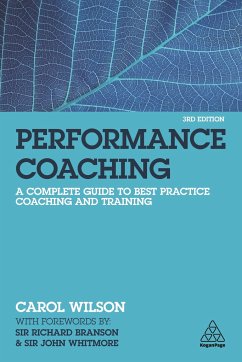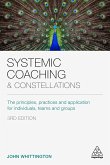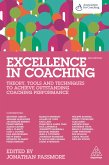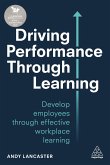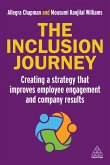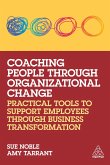- Broschiertes Buch
- Merkliste
- Auf die Merkliste
- Bewerten Bewerten
- Teilen
- Produkt teilen
- Produkterinnerung
- Produkterinnerung
Use this bestselling guide to embed a coaching culture in any organization to increase performance.
Andere Kunden interessierten sich auch für
![Systemic Coaching and Constellations Systemic Coaching and Constellations]() John Whittington (Coach, facilitator, author)Systemic Coaching and Constellations34,99 €
John Whittington (Coach, facilitator, author)Systemic Coaching and Constellations34,99 €![Excellence in Coaching Excellence in Coaching]() Jonathan PassmoreExcellence in Coaching52,99 €
Jonathan PassmoreExcellence in Coaching52,99 €![Impact Players Impact Players]() Liz WisemanImpact Players28,99 €
Liz WisemanImpact Players28,99 €![Driving Performance through Learning Driving Performance through Learning]() Andy LancasterDriving Performance through Learning26,99 €
Andy LancasterDriving Performance through Learning26,99 €![The Inclusion Journey The Inclusion Journey]() Allegra ChapmanThe Inclusion Journey45,99 €
Allegra ChapmanThe Inclusion Journey45,99 €![Coaching People Through Organizational Change: Practical Tools to Support Employees Through Business Transformation Coaching People Through Organizational Change: Practical Tools to Support Employees Through Business Transformation]() Sue NobleCoaching People Through Organizational Change: Practical Tools to Support Employees Through Business Transformation45,99 €
Sue NobleCoaching People Through Organizational Change: Practical Tools to Support Employees Through Business Transformation45,99 €![Learning and Development Practice in the Workplace Learning and Development Practice in the Workplace]() Kathy BeeversLearning and Development Practice in the Workplace74,99 €
Kathy BeeversLearning and Development Practice in the Workplace74,99 €-
-
-
Use this bestselling guide to embed a coaching culture in any organization to increase performance.
Hinweis: Dieser Artikel kann nur an eine deutsche Lieferadresse ausgeliefert werden.
Hinweis: Dieser Artikel kann nur an eine deutsche Lieferadresse ausgeliefert werden.
Produktdetails
- Produktdetails
- Verlag: Kogan Page Ltd
- 3 Revised edition
- Seitenzahl: 432
- Erscheinungstermin: 27. Oktober 2020
- Englisch
- Abmessung: 231mm x 156mm x 25mm
- Gewicht: 654g
- ISBN-13: 9781789664461
- ISBN-10: 1789664462
- Artikelnr.: 57576047
- Herstellerkennzeichnung
- Libri GmbH
- Europaallee 1
- 36244 Bad Hersfeld
- gpsr@libri.de
- Verlag: Kogan Page Ltd
- 3 Revised edition
- Seitenzahl: 432
- Erscheinungstermin: 27. Oktober 2020
- Englisch
- Abmessung: 231mm x 156mm x 25mm
- Gewicht: 654g
- ISBN-13: 9781789664461
- ISBN-10: 1789664462
- Artikelnr.: 57576047
- Herstellerkennzeichnung
- Libri GmbH
- Europaallee 1
- 36244 Bad Hersfeld
- gpsr@libri.de
Carol Wilson is a Fellow of the Institute of Leadership and Management, the Association for Coaching, and the Professional Speaking Association. She is on the Global Advisory Panel at the Association for Coaching and a Trustee to the non-profit MOE Foundation, where she designs coaching programmes for underprivileged young people and the African Prisons Project. A multicultural expert, Carol Wilson has designed coaching and leadership programmes all over the world for organisations including IKEA, Philip Morris, the BBC, Hilti and NCR. She has won and been nominated for several awards for coaching and writing. She is the author of Performance Coaching, A Complete Guide to Best Practice Coaching and Training featuring forewords by Sir John Whitmore and Sir Richard Branson; she has also contributed to 6 books and published over 50 articles. Carol experienced the value of a coaching culture firsthand during a decade working at board level with Sir Richard Branson at Virgin. Later she held board-level positions with Island Records, Warner Brothers and Polygram. Since entering the coaching field in 2000 she has studied with thought leaders including Nancy Kline and Tim Gallwey, and collaborated with Sir John Whitmore David Grove. She is a keynote speaker at conferences worldwide including The HR Summit Budapest, the Asian Emerging Leaders Summit Hong Kong, Guts for Change Mumbai, Catalyst Australia, HRD London, and the China Executive Coaching Conference Shanghai.
Section
ONE: The fundamentals of performance coaching; Chapter
01: What is coaching?; Chapter
02: The differences between coaching, therapy, counselling, mentoring and consultancy; Chapter
03: The directive
non
directive continuum; Chapter
04: Self
limiting beliefs; Chapter
05: Coaching and neuroscience; Section
TWO: Creating a coaching culture in organizations; Chapter
06: The meaning of a coaching culture; Chapter
07: Ten steps to creating a coaching culture; Chapter
08: Coaching in the workplace; Chapter
09: Coach training in the workplace; Chapter
10: Coaching in leadership; Chapter
11: Cross
cultural coaching; Chapter
12: Distance coach training; Chapter
13: Coaching in schools; Chapter
14: Coaching for Crisis at Christmas; Chapter
15: Corporate social responsibility and shared value
bringing business and society back together; Chapter
16: Bullying in the workplace; Chapter
17: Resilience in leadership; Chapter
18: Coaching supervision: a workplace perspective; Chapter
19: ROI
Measuring the return on investment in coaching; Section
THREE: Skills for coaches and managers; Chapter
20: Listening; Chapter
21: Reflecting, summarizing and clarifying; Chapter
22: Questioning; Chapter
23: Permission protocol; Chapter
24: The GROW coaching model; Chapter
25: The EXACT model
a coaching approach to goal setting; Chapter
26: Coaching feedback; Chapter
27: The structure of coaching; Chapter
28: Setting and reviewing actions; Section
FOUR: Tools of the trade
continuing professional development; Chapter
29: David Grove's Clean Language; Chapter
30: David Grove's Emergent Knowledge; Chapter
31: Transpersonal coaching; Chapter
32: An introduction to neuro
linguistic programming; Chapter
33: Systemic Coaching; Chapter
34: Transactional analysis and the OK Corral; Chapter
35: 360
degree feedback; Chapter
36: The Reuven Bar
On Emotional Quotient inventory (BarOn EQ
i); Chapter
37: Thomas
Kilmann Conflict Mode Instrument; Chapter
38: Marshall Rosenberg's 'Non
Violent Communication'; Chapter
39: Peer leadership Chapter
40: Situational Leadership; Chapter
41: Kouzes and Posner: The Leadership Challenge; Chapter
42: Cultural Transformation Tools; Chapter
43: The Inner Game; Chapter
44: Nancy Kline's Thinking Environment; Chapter
45: Appreciative Inquiry; Chapter
46: Mindfulness; Chapter
47: Elizabeth Kubler Ross's Change Curve six stage model; Chapter
48: Bruce Tuckman's 'forming, storming, norming and performing' team development model; Chapter
49: The Myers
Briggs Type Indicator (MBTI®); Chapter
50: The Enneagram; Chapter
51: Kolb's learning styles; Chapter
52: DISC; Chapter
53: Johari Window; Chapter
54: More team role models
ONE: The fundamentals of performance coaching; Chapter
01: What is coaching?; Chapter
02: The differences between coaching, therapy, counselling, mentoring and consultancy; Chapter
03: The directive
non
directive continuum; Chapter
04: Self
limiting beliefs; Chapter
05: Coaching and neuroscience; Section
TWO: Creating a coaching culture in organizations; Chapter
06: The meaning of a coaching culture; Chapter
07: Ten steps to creating a coaching culture; Chapter
08: Coaching in the workplace; Chapter
09: Coach training in the workplace; Chapter
10: Coaching in leadership; Chapter
11: Cross
cultural coaching; Chapter
12: Distance coach training; Chapter
13: Coaching in schools; Chapter
14: Coaching for Crisis at Christmas; Chapter
15: Corporate social responsibility and shared value
bringing business and society back together; Chapter
16: Bullying in the workplace; Chapter
17: Resilience in leadership; Chapter
18: Coaching supervision: a workplace perspective; Chapter
19: ROI
Measuring the return on investment in coaching; Section
THREE: Skills for coaches and managers; Chapter
20: Listening; Chapter
21: Reflecting, summarizing and clarifying; Chapter
22: Questioning; Chapter
23: Permission protocol; Chapter
24: The GROW coaching model; Chapter
25: The EXACT model
a coaching approach to goal setting; Chapter
26: Coaching feedback; Chapter
27: The structure of coaching; Chapter
28: Setting and reviewing actions; Section
FOUR: Tools of the trade
continuing professional development; Chapter
29: David Grove's Clean Language; Chapter
30: David Grove's Emergent Knowledge; Chapter
31: Transpersonal coaching; Chapter
32: An introduction to neuro
linguistic programming; Chapter
33: Systemic Coaching; Chapter
34: Transactional analysis and the OK Corral; Chapter
35: 360
degree feedback; Chapter
36: The Reuven Bar
On Emotional Quotient inventory (BarOn EQ
i); Chapter
37: Thomas
Kilmann Conflict Mode Instrument; Chapter
38: Marshall Rosenberg's 'Non
Violent Communication'; Chapter
39: Peer leadership Chapter
40: Situational Leadership; Chapter
41: Kouzes and Posner: The Leadership Challenge; Chapter
42: Cultural Transformation Tools; Chapter
43: The Inner Game; Chapter
44: Nancy Kline's Thinking Environment; Chapter
45: Appreciative Inquiry; Chapter
46: Mindfulness; Chapter
47: Elizabeth Kubler Ross's Change Curve six stage model; Chapter
48: Bruce Tuckman's 'forming, storming, norming and performing' team development model; Chapter
49: The Myers
Briggs Type Indicator (MBTI®); Chapter
50: The Enneagram; Chapter
51: Kolb's learning styles; Chapter
52: DISC; Chapter
53: Johari Window; Chapter
54: More team role models
Section
ONE: The fundamentals of performance coaching; Chapter
01: What is coaching?; Chapter
02: The differences between coaching, therapy, counselling, mentoring and consultancy; Chapter
03: The directive
non
directive continuum; Chapter
04: Self
limiting beliefs; Chapter
05: Coaching and neuroscience; Section
TWO: Creating a coaching culture in organizations; Chapter
06: The meaning of a coaching culture; Chapter
07: Ten steps to creating a coaching culture; Chapter
08: Coaching in the workplace; Chapter
09: Coach training in the workplace; Chapter
10: Coaching in leadership; Chapter
11: Cross
cultural coaching; Chapter
12: Distance coach training; Chapter
13: Coaching in schools; Chapter
14: Coaching for Crisis at Christmas; Chapter
15: Corporate social responsibility and shared value
bringing business and society back together; Chapter
16: Bullying in the workplace; Chapter
17: Resilience in leadership; Chapter
18: Coaching supervision: a workplace perspective; Chapter
19: ROI
Measuring the return on investment in coaching; Section
THREE: Skills for coaches and managers; Chapter
20: Listening; Chapter
21: Reflecting, summarizing and clarifying; Chapter
22: Questioning; Chapter
23: Permission protocol; Chapter
24: The GROW coaching model; Chapter
25: The EXACT model
a coaching approach to goal setting; Chapter
26: Coaching feedback; Chapter
27: The structure of coaching; Chapter
28: Setting and reviewing actions; Section
FOUR: Tools of the trade
continuing professional development; Chapter
29: David Grove's Clean Language; Chapter
30: David Grove's Emergent Knowledge; Chapter
31: Transpersonal coaching; Chapter
32: An introduction to neuro
linguistic programming; Chapter
33: Systemic Coaching; Chapter
34: Transactional analysis and the OK Corral; Chapter
35: 360
degree feedback; Chapter
36: The Reuven Bar
On Emotional Quotient inventory (BarOn EQ
i); Chapter
37: Thomas
Kilmann Conflict Mode Instrument; Chapter
38: Marshall Rosenberg's 'Non
Violent Communication'; Chapter
39: Peer leadership Chapter
40: Situational Leadership; Chapter
41: Kouzes and Posner: The Leadership Challenge; Chapter
42: Cultural Transformation Tools; Chapter
43: The Inner Game; Chapter
44: Nancy Kline's Thinking Environment; Chapter
45: Appreciative Inquiry; Chapter
46: Mindfulness; Chapter
47: Elizabeth Kubler Ross's Change Curve six stage model; Chapter
48: Bruce Tuckman's 'forming, storming, norming and performing' team development model; Chapter
49: The Myers
Briggs Type Indicator (MBTI®); Chapter
50: The Enneagram; Chapter
51: Kolb's learning styles; Chapter
52: DISC; Chapter
53: Johari Window; Chapter
54: More team role models
ONE: The fundamentals of performance coaching; Chapter
01: What is coaching?; Chapter
02: The differences between coaching, therapy, counselling, mentoring and consultancy; Chapter
03: The directive
non
directive continuum; Chapter
04: Self
limiting beliefs; Chapter
05: Coaching and neuroscience; Section
TWO: Creating a coaching culture in organizations; Chapter
06: The meaning of a coaching culture; Chapter
07: Ten steps to creating a coaching culture; Chapter
08: Coaching in the workplace; Chapter
09: Coach training in the workplace; Chapter
10: Coaching in leadership; Chapter
11: Cross
cultural coaching; Chapter
12: Distance coach training; Chapter
13: Coaching in schools; Chapter
14: Coaching for Crisis at Christmas; Chapter
15: Corporate social responsibility and shared value
bringing business and society back together; Chapter
16: Bullying in the workplace; Chapter
17: Resilience in leadership; Chapter
18: Coaching supervision: a workplace perspective; Chapter
19: ROI
Measuring the return on investment in coaching; Section
THREE: Skills for coaches and managers; Chapter
20: Listening; Chapter
21: Reflecting, summarizing and clarifying; Chapter
22: Questioning; Chapter
23: Permission protocol; Chapter
24: The GROW coaching model; Chapter
25: The EXACT model
a coaching approach to goal setting; Chapter
26: Coaching feedback; Chapter
27: The structure of coaching; Chapter
28: Setting and reviewing actions; Section
FOUR: Tools of the trade
continuing professional development; Chapter
29: David Grove's Clean Language; Chapter
30: David Grove's Emergent Knowledge; Chapter
31: Transpersonal coaching; Chapter
32: An introduction to neuro
linguistic programming; Chapter
33: Systemic Coaching; Chapter
34: Transactional analysis and the OK Corral; Chapter
35: 360
degree feedback; Chapter
36: The Reuven Bar
On Emotional Quotient inventory (BarOn EQ
i); Chapter
37: Thomas
Kilmann Conflict Mode Instrument; Chapter
38: Marshall Rosenberg's 'Non
Violent Communication'; Chapter
39: Peer leadership Chapter
40: Situational Leadership; Chapter
41: Kouzes and Posner: The Leadership Challenge; Chapter
42: Cultural Transformation Tools; Chapter
43: The Inner Game; Chapter
44: Nancy Kline's Thinking Environment; Chapter
45: Appreciative Inquiry; Chapter
46: Mindfulness; Chapter
47: Elizabeth Kubler Ross's Change Curve six stage model; Chapter
48: Bruce Tuckman's 'forming, storming, norming and performing' team development model; Chapter
49: The Myers
Briggs Type Indicator (MBTI®); Chapter
50: The Enneagram; Chapter
51: Kolb's learning styles; Chapter
52: DISC; Chapter
53: Johari Window; Chapter
54: More team role models

